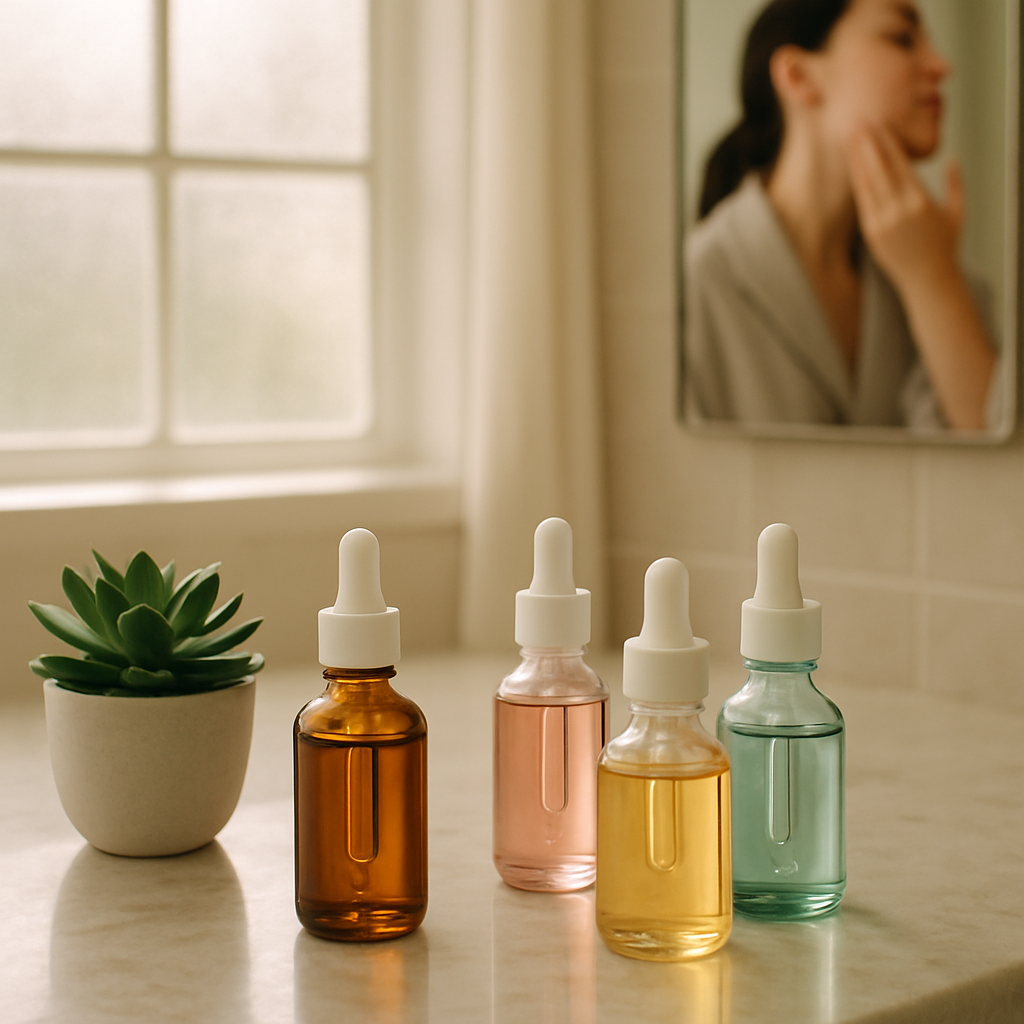The Ultimate Guide to Facial Serums for Every Skin Type

Facial serums have emerged as powerhouse products in skincare routines worldwide. These concentrated formulations deliver active ingredients directly to your skin, targeting specific concerns with precision that other products simply can’t match. Unlike heavier creams and moisturizers, serums contain smaller molecules that penetrate deeply, making them incredibly effective for addressing everything from dehydration to hyperpigmentation.
Many people feel overwhelmed by the vast array of serum options available today. With prices ranging from budget-friendly to eye-wateringly expensive, how do you know which ones are worth your money? And more importantly, which ones will actually work for your unique skin type?
I’ve spent years testing products (and dealing with my own sensitive skin disasters) to understand what truly works. Let’s break down the world of facial serums what they are, why they matter, and how to choose the perfect formula for your specific skin needs.
Understanding What Makes Serums Special
Facial serums are lightweight, concentrated liquids packed with active ingredients. They typically have a thinner consistency than moisturizers and are designed to be applied after cleansing but before moisturizing.
What makes serums different from other skincare products is their potency and ability to target specific skin concerns. While moisturizers primarily focus on hydration and creating a protective barrier, serums can address a wide range of issues from fine lines to uneven skin tone.
The molecular structure of serums allows them to penetrate deeper into the skin than other products. This means those expensive active ingredients you’re paying for actually reach where they need to go rather than sitting on the surface.
I remember buying my first “fancy” serum about eight years ago a vitamin C formula that cost more than I wanted to admit to my roommate. I applied it religiously every morning, and within three weeks, people started commenting on how bright my skin looked. That experience converted me into a serum believer.
Of course, not all serums are created equal. Some contain fillers and minimal active ingredients, while others pack a serious punch with concentrated formulas. Price isn’t always an indicator of quality either I’ve found $15 serums that outperform $150 ones.
Finding Your Perfect Match Based on Skin Type
Dry Skin Heroes
If your skin feels tight, flaky, or just perpetually thirsty, hydrating serums containing hyaluronic acid should be your go-to. Hyaluronic acid can hold up to 1,000 times its weight in water, drawing moisture into your skin.
Look for serums that combine different molecular weights of hyaluronic acid for both immediate surface hydration and deeper, longer-lasting effects. Products containing glycerin, panthenol, or ceramides alongside hyaluronic acid provide additional moisture-locking benefits.
For extremely dry skin, consider layering a hydrating serum under a serum containing squalane or plant oils. This combination addresses both water and oil deficiencies that contribute to dryness.
I’ve struggled with dry patches around my nose during winter months for years. Last December, I started using a hyaluronic acid serum followed by three drops of a squalane serum, and it was the first winter I didn’t experience flaking. The key was applying the hyaluronic acid while my skin was still slightly damp from washing.
Oily and Acne-Prone Skin Solutions
Contrary to what you might think, serums can be game-changing for oily skin types. The right formula can help regulate sebum production while treating existing breakouts.
Niacinamide (vitamin B3) serums at 5-10% concentration can reduce oil production, minimize pore appearance, and strengthen your skin barrier. Salicylic acid serums work brilliantly for acne-prone skin by exfoliating inside the pores, removing debris that leads to breakouts.
For persistent acne, consider retinol serums used at night. Start with a lower concentration (0.25-0.5%) and gradually work your way up to prevent irritation. These regulate cell turnover, preventing the clogged pores that lead to breakouts.
My friend Sam dealt with adult acne for years until finding a routine centered around a niacinamide serum in the morning and a gentle retinol serum at night. The combination addressed both active breakouts and the post-inflammatory hyperpigmentation left behind.
Combination Skin Strategies
Dealing with combination skin can feel like trying to please two completely different skin types at once. The key is targeted application or finding balanced formulas.
Consider using different serums on different areas of your face. A hydrating hyaluronic acid serum can work wonders on dry cheeks, while a niacinamide serum can help manage oiliness in the T-zone.
Multi-tasking serums containing both hydrating and balancing ingredients work well for combination skin. Look for formulas with hyaluronic acid, niacinamide, and antioxidants that address multiple concerns simultaneously.
I have combination skin myself, and found that applying a hydrating serum all over followed by a drop of oil-controlling serum just on my T-zone works beautifully. It took some experimentation, but this approach finally addressed both my dry cheeks and shiny forehead.
Sensitive Skin Saviors
Finding serums for sensitive skin requires extra caution. Many highly active formulas can trigger reactions, but that doesn’t mean you should avoid serums altogether.
Look for serums with minimal ingredient lists focused on soothing components like centella asiatica, green tea extract, panthenol, or allantoin. These calm inflammation while providing benefits without irritation.
Avoid serums with high concentrations of potentially irritating ingredients like fragrance, essential oils, alcohol, and high percentages of exfoliating acids or retinol until you know how your skin responds.
I learned this lesson the hard way after trying a popular vitamin C serum that left my face red and stinging for days. Now I patch test everything on my jawline for at least 48 hours before applying to my entire face.
Aging Skin Support
As skin matures, serums become even more valuable tools in your skincare arsenal. The right formulas can address multiple signs of aging simultaneously.
Vitamin C serums (look for L-ascorbic acid at 10-20%) provide antioxidant protection while brightening and stimulating collagen production. For best results, use these in the morning under sunscreen.
Peptide serums support collagen and elastin production, improving firmness and elasticity over time. These work well for those who find retinol too irritating.
Retinol remains the gold standard for aging skin, increasing cell turnover and stimulating collagen production. If you’re new to retinol, start with a lower percentage (0.25-0.5%) and use it just 2-3 times weekly, gradually increasing frequency as your skin adjusts.
My mom started using a peptide serum in her 60s after finding retinol too harsh. After six months of consistent use, she noticed significant improvement in her skin’s firmness, particularly around her jawline.
Layering and Application Techniques
Getting the most from your serums isn’t just about choosing the right formula it’s also about how you apply them.
Always apply serums to clean, slightly damp skin for maximum absorption. Most serums work best when applied from thinnest to thickest consistency. Water-based serums should generally go before oil-based ones.
A little goes a long way with serums typically 3-4 drops is sufficient for your entire face. Gently press the serum into your skin rather than rubbing vigorously. This ensures maximum absorption without irritation.
When using multiple serums, wait about 30 seconds between applications to allow each product to absorb properly. If you’re using both vitamin C and retinol serums, consider using vitamin C in the morning and retinol at night to prevent potential irritation and maximize effectiveness.
I’ve found that storing certain serums in the refrigerator particularly vitamin C formulas not only extends their shelf life but also provides a refreshing application experience that helps reduce morning puffiness.
Common Serum Mistakes to Avoid
Many people undermine their serum’s effectiveness through improper use. Using too much product doesn’t increase benefits it just wastes your money and can potentially cause irritation.
Mixing incompatible ingredients can neutralize their effectiveness or cause reactions. For example, retinol shouldn’t be used simultaneously with AHAs/BHAs or vitamin C, as this can cause excessive irritation or render the ingredients ineffective.
Expecting overnight miracles leads to disappointment. Most serums take 4-12 weeks of consistent use to show significant results. Take progress photos every few weeks rather than scrutinizing your face daily.
Not giving serums time to absorb before applying moisturizer can dilute their effectiveness. Wait at least 30-60 seconds between steps for optimal results.
Facial serums represent one of the most effective ways to address specific skin concerns, but finding your perfect match requires understanding both your skin’s needs and how different ingredients work. Start with one well-formulated serum targeting your primary concern, and add others as needed.
With consistent use and proper application, the right serum can transform your skin in ways that other products simply can’t match. Your perfect serum match is out there it might take some experimentation to find it, but your skin will thank you for the effort.


